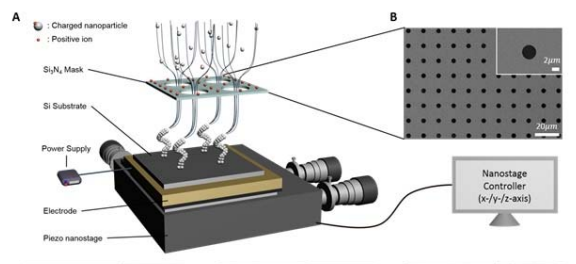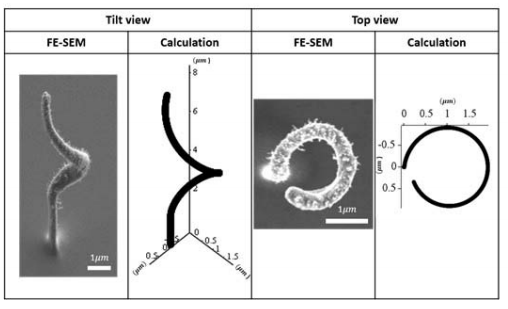In a paper entitled “Three-dimensional nanoprinting via charged aerosol focusing,” a group of researchers describes a 3D nanoprinting method to create versatile nanostructures that cannot easily be created with existing methods. They applied a floating dielectric mask concept combined with 3D translation of piezoelectic nanostage to focus charged aerosols through a convergent electrostatic field through apertures in the floating mask. By fine-tuning the 3D translation speed and direction of the nanostage, the researchers were able to determine the shape of the 3D nanostructures.
The researchers discovered that two different regimes – 3D growth mode and 3D writing mode – existed, depending on the translation velocity of the stage.
“In the 3D growth mode, the shape of structure is determined by adjusting the stage translation speed according to the growth rate of the structure,” the researchers explain. “Adding the horizontal movement of the stage enables the manufacturing of slanted structures in various angles. Precise 3-axis stage controlling can lead to complex 3D nanostructures. Relatively faster movement of stage would lead to 3D writing mode, in which nanoparticles cannot be accumulated upon the existing cluster and the movement of the stage makes a line of particles. This means that the multiple sweeping with a same orbit makes the writing of 3D nanostructures.”
The production of a scaffold for the parallel structure growth in 3D was based on a floating dielectric mask with an array of holes. The positively charged ions and aerosol nanoparticles created in a spark discharge were directed toward the mask and substrate by the electric field that controls the deposition process with the potential on the substrate.
“The role of the electric field is very complex: positive ions trapped by the mask out of the flow create a positively charged cushion on the mask,” the researchers continue. “The cushion is shaped by the electric field from the ion distribution on the mask hole array so that the resulting electric field is repelling for the aerosol nanoparticles everywhere over the mask except the hole regions where it produces narrow funnels.”
The nanoparticle stream focused within the funnels is directed to a given position on the substrate, controlled by the nanostage position. When the stage does not move, the pillars grow, and the mask hole array controls the resulting pillar array. By alternating the types of nanoparticles during the deposition, the pillars could be composed of complex, multiple materials.
“The full capacity of the 3D printing method is revealed when the stage moves controllably during the deposition process,” the researchers state. “The complete control over the structure growth shape becomes possible due to the further focusing of the electric field lines in the funnel onto exclusively the tip of the growing structure. The tip follows the electric field line and thus the latter plays the role of a drawing tool.”
The scaffold used by this method of 3D printing has no restrictions in terms of size, so it can be scaled down to atomic sizes or up to mescopic ones, according to the researchers. It can also be used with a wide variety of materials, opening up possibilities for producing hybrid structures needed in electronic devices.
Authors of the paper include Wooik Jung, Yoon-ho Jung, Peter V. Pikhitsa, Jooyeon Shin, Kijoon Bang, Jicheng Feng and Mansoo Choi.
Discuss this and other 3D printing topics at 3DPrintBoard.com or share your thoughts below.
Subscribe to Our Email Newsletter
Stay up-to-date on all the latest news from the 3D printing industry and receive information and offers from third party vendors.
You May Also Like
Gorilla Sports GE’s First 3D Printed Titanium Cast
How do you help a gorilla with a broken arm? Sounds like the start of a bad joke a zookeeper might tell, but it’s an actual dilemma recently faced by...
Nylon 3D Printed Parts Made More Functional with Coatings & Colors
Parts 3D printed from polyamide (PA, Nylon) 12 using powder bed fusion (PBF) are a mainstay in the additive manufacturing (AM) industry. While post-finishing processes have improved the porosity of...
$25M to Back Sintavia’s Largest Expansion of Metal 3D Printing Capacity Since 2019
Sintavia, the digital manufacturing company specializing in mission-critical parts for strategic sectors, announced a $25 million investment to increase its production capacity, the largest expansion to its operations since 2019....
Velo3D Initiates Public Offering in a Bid to Strengthen Financial Foundations and Drive Future Growth
Velo3D (NYSE: VLD) has been among a number of publicly traded 3D printing firms that have attempted to weather the current macroeconomic climate. After posting a challenging financial report for 2023,...
































